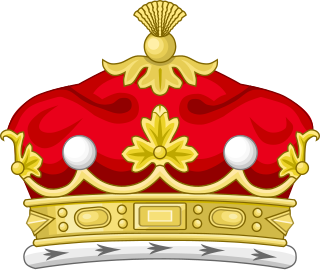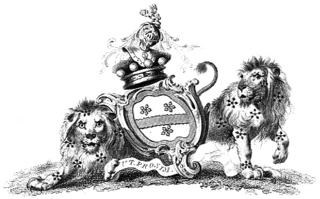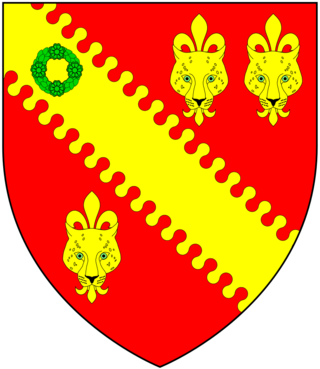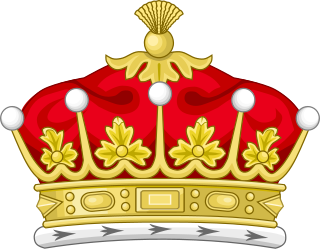Coat of arms
 |
|
Baron Crawshaw, of Crawshaw in the County Palatine of Lancaster and of Whatton in the County of Leicester is a title in the Peerage of the United Kingdom. It was created on 25 August 1892 for Sir Thomas Brooks, 1st Baronet. [1] He notably served as High Sheriff of Lancashire in 1884. Brooks had already been created a baronet in the Baronetage of the United Kingdom, of Crawshaw Hall and Whatton House, on 9 February 1891. As of 2013 [update] the titles are held by his great-grandson, the fifth Baron, who succeeded his elder brother in 1997.
The family seat is Whatton House near Loughborough in Leicestershire.
The heir presumptive is the present holder's nephew, Edward Samuel Brooks (b. 1969).
Next in line is the present holder's cousin Timothy Allan William Brooks (b. 1962), grandson of Hon. Herbert William Brooks (1890-1974), the younger son of the 2nd Baron. He has a daughter, Sophie (b. 2002) and a son, Rupert James (b. 2003).
 |
|
This article includes a list of general references, but it lacks sufficient corresponding inline citations .(November 2021) |

Marquess of Zetland is a title in the Peerage of the United Kingdom. It was created on 22 August 1892 for the former Lord Lieutenant of Ireland, Lawrence Dundas, 3rd Earl of Zetland. Zetland is an archaic form of Shetland. The Dundas family descends from the wealthy Scottish businessman and Member of Parliament, Lawrence Dundas. In 1762 he was created a Baronet, of Kerse in the County of Linlithgow, in the Baronetage of Great Britain. The title was created with remainder, failing heirs male of his own, to his brother Thomas Dundas and the heirs male of his body. He was succeeded by his son, the second Baronet. He represented Richmond and Stirling in the House of Commons and also served as Lord Lieutenant of Orkney and Shetland. In 1794 he was created Baron Dundas, of Aske in the North Riding of the County of York, in the Peerage of Great Britain. Lord Dundas notably purchased the right to the earldom of Orkney and lordship of Zetland from James Douglas, 14th Earl of Morton.
Baron Marchamley, of Hawkestone in the County of Salop, is a title in the Peerage of the United Kingdom. It was created in 1908 for the Liberal politician George Whiteley, who had previously represented Stockport and Pudsey in the House of Commons. As of 2014 the title is held by his great-grandson, the fourth Baron, who succeeded his father in 1994.

Baron Foley is a title that has been created twice in the Peerage of Great Britain, both times for members of the same family.
Baron Huntingfield is a title created three times, twice in the Peerage of England and once in the Peerage of Ireland. The first two creations were by writ, but little more is known about them, except that John de Huntingfield, who was created Baron Huntingfield in 1362, married Margery de Welles, daughter of John de Welles, 4th Baron Welles. John was dead by December 1376, when Margery remarried. Both titles probably became extinct or fell into abeyance on the death of their first holders. The third creation, Baron Huntingfield, of Heveningham Hall in the County of Suffolk, was created in the Peerage of Ireland in 1796 for Sir Joshua Vanneck, 3rd Baronet, Member of Parliament for Dunwich. His son, the second Baron, also represented this constituency in the House of Commons. His great-grandson, the fifth Baron, was Conservative Member of Parliament for Eye and Governor of Victoria. As of 2013 the titles are held by the latter's grandson, the seventh Baron, who succeeded his father in 1994.
Baron Grimthorpe, of Grimthorpe in the East Riding of the County of York, is a title in the Peerage of the United Kingdom. It was created on 17 February 1886 for the lawyer and architect Edmund Beckett, 5th Baronet, with remainder to the heirs male of his father. He was succeeded according to the special remainder by his nephew, the second Baron. He had earlier represented Grimsby in Parliament. As of 2014 the titles are held by the latter's great-grandson, the fifth Baron, who succeeded his father in 2003.

Baron Denman, of Dovedale in the County of Derby, is a title in the Peerage of the United Kingdom. It was created in 1834 for the prominent lawyer, judge and Whig politician Thomas Denman. He served as Lord Chief Justice of the King's Bench from 1832 to 1850. His son, the second Baron, assumed in 1876 by royal licence the additional surname of Aitchison, which was that of his father-in-law. He was succeeded by his grandnephew, the third Baron. He was the grandson of the Hon. Richard Denman, younger son of the first Baron. Lord Denman notably served as Governor-General of Australia from 1911 to 1914. He was succeeded by his eldest son, the fourth Baron. On his death in 1971, the title passed to his first cousin, Sir Charles Denman, 2nd Baronet, of Staffield, who became the fifth holder of the title.
Baron de Mauley, of Canford in the County of Dorset, is a title in the Peerage of the United Kingdom. It was created on 10 July 1838 for the Whig politician the Hon. William Ponsonby, who had earlier represented Poole, Knaresborough and Dorset in the House of Commons. He was the third son of the 3rd Earl of Bessborough, an Anglo-Irish peer, and his wife Lady Henrietta Spencer, daughter of the 1st Earl Spencer. He married Lady Barbara Ashley-Cooper, the daughter of Anthony Ashley-Cooper, 5th Earl of Shaftesbury. She was one of the co-heirs to the ancient barony by writ of Mauley, which superseded the feudal barony the caput of which was at Mulgrave Castle, Yorkshire, which barony by writ had become extinct in 1415.
Baron de Ramsey, of Ramsey Abbey in the County of Huntingdon, is a title in the Peerage of the United Kingdom. It was created in 1887 for Edward Fellowes, who had previously represented Huntingdonshire in the House of Commons as a Conservative for 43 years. His eldest son, the second Baron, sat as Member of Parliament for Huntingdonshire and Ramsey and later served as a Lord-in-waiting from 1890 to 1892 in the Conservative administration of Lord Salisbury. His grandson, the third Baron, was Lord Lieutenant of Huntingdonshire from 1947 to 1965 and of Huntingdon and Peterborough between 1965 and 1968. As of 2017 the title is held by the latter's son, the fourth Baron, who succeeded in 1993.

Baron Leigh has been created twice as a hereditary title, once in the Peerage of England and once in the Peerage of the United Kingdom. The writer Jane Austen is associated with this dynasty.

Baron Newton, of Newton-in-Makerfield in the County Palatine of Lancaster, is a title in the Peerage of the United Kingdom. It was created in 1892 for the Conservative politician William Legh, who had earlier represented Lancashire South and Cheshire East in the House of Commons.

Baron Merthyr, of Senghenydd in the County of Glamorgan, is a title in the Peerage of the United Kingdom. It was created in 1911 for the Welsh coal mining magnate Sir William Lewis, 1st Baronet. He had already been created a baronet, of Nantgwyne in the County of Glamorgan, in 1896. The barony is named after the town of Merthyr Tydfil, where Lewis was born. Lord Merthyr's grandson, the third Baron, was Chairman of Committees in the House of Lords from 1957 to 1965 and a Deputy Speaker from 1957 to 1974. The latter was succeeded by his son, the fourth Baron. He disclaimed the peerage for life on 26 April 1977, three weeks after succeeding his father. He did not use his title of baronet either. He died on 5 August 2015.

Baron Tennyson, of Aldworth in the County of Sussex and of Freshwater in the Isle of Wight, is a title in the Peerage of the United Kingdom. It was created in 1884 for the poet Alfred Tennyson. His son, the second Baron, served as Governor-General of Australia, and his grandson, the third Baron, as a captain for the English cricket team. On the death in 2006 of the latter's younger son, the fifth Baron, the line of the eldest son of the first Baron failed. The title was inherited by the late Baron's second cousin once removed, the sixth and present holder of the peerage. He is the great-grandson of Hon. Lionel Tennyson, second son of the first Baron.
Baron Congleton, of Congleton in the County Palatine of Chester, is a title in the Peerage of the United Kingdom. It was created in 1841 for the Whig politician, former Secretary at War, and Paymaster of the Forces Sir Henry Parnell, 4th Baronet. His eldest son, the second Baron, devoted his life to religious work and was an early member of the Plymouth Brethren. The latter was succeeded by his younger brother, the third Baron. He served in the Royal Navy and fought at the Battle of Navarino in 1827. His eldest surviving son, the fourth Baron, was a major general in the British Army and served in the Crimean War and the Anglo-Zulu War. The latter's eldest son, the fifth Baron, was killed in action in Ypres Salient during the First World War and was succeeded by his younger brother, the sixth Baron. As of 2015, the titles are held by the latter's grandson, the ninth Baron, who succeeded his father in 2015.

Baron Carnock, of Carnock in the County of Stirling, is a title in the Peerage of the United Kingdom. It was created in 1916 for the former Permanent Under-Secretary in the Foreign Office, Sir Arthur Nicolson, 11th Baronet.
Baron Cawley, of Prestwich in the County Palatine of Lancaster, is a title in the Peerage of the United Kingdom. It was created in 1918 for the Liberal politician Sir Frederick Cawley, 1st Baronet. He had previously represented Prestwich in the House of Commons and served as Chancellor of the Duchy of Lancaster from 1916 to 1918. Before his elevation to the peerage, Cawley had been created a baronet, of Prestwich in the County Palatine of Lancaster, in the Baronetage of the United Kingdom, in 1906. His grandson, the third Baron, notably served as Deputy Chairman of Committees in the House of Lords from 1958 to 1967. As of 2023 the titles are held by the latter's eldest son, the fourth Baron, who succeeded in 2001.
Baron Clwyd, of Abergele in the County of Denbigh, is a title in the Peerage of the United Kingdom. It was created in 1919 for the Liberal politician Sir John Roberts, 1st Baronet, who had previously represented Denbighshire West in the House of Commons. He had already been created a Baronet, of Brynwenallt in the parish of Abergele in the County of Denbigh, in the Baronetage of the United Kingdom in 1908. Lord Clwyd's father John Roberts had earlier been Member of Parliament for Flint from 1878 to 1892. As of 2016 the titles are held by his great-grandson, the fourth Baron, who succeeded his father in 2006.

Thomas Brooks, 1st Baron Crawshaw, was a British peer.
There have been two baronetcies created for persons with the surname Brooks, both in the Baronetage of the United Kingdom: one creation is extant as of 2007.
Baron Dunleath, of Ballywalter in the County of Down, is a title in the Peerage of the United Kingdom. It was created on 29 August 1892 for the businessman and former Conservative Member of Parliament for Downpatrick, John Mulholland. The Mulholland family were involved in the cotton and linen industry in Ulster in the north of Ireland. The first Baron's son, the second Baron, represented Londonderry North in the House of Commons as a Conservative. His grandson, the fourth Baron, was a member of the Northern Ireland Assembly for the Alliance Party. He was succeeded by his first cousin, the fifth Baron, who had already succeeded his father as second Baronet of Ballyscullion. As of 2017 the titles are held by the fifth Baron's son, the sixth Baron, who succeeded in 1997.

Earl of Arran is a title in the Peerage of Ireland. It is not to be confused with the title Earl of Arran in the Peerage of Scotland. The two titles refer to different places: the Aran Islands in Ireland, and the Isle of Arran in Scotland. The Irish earldom is held by the Gore family. The Scottish earldom is a separate title, held as a subsidiary title of the Duke of Hamilton.